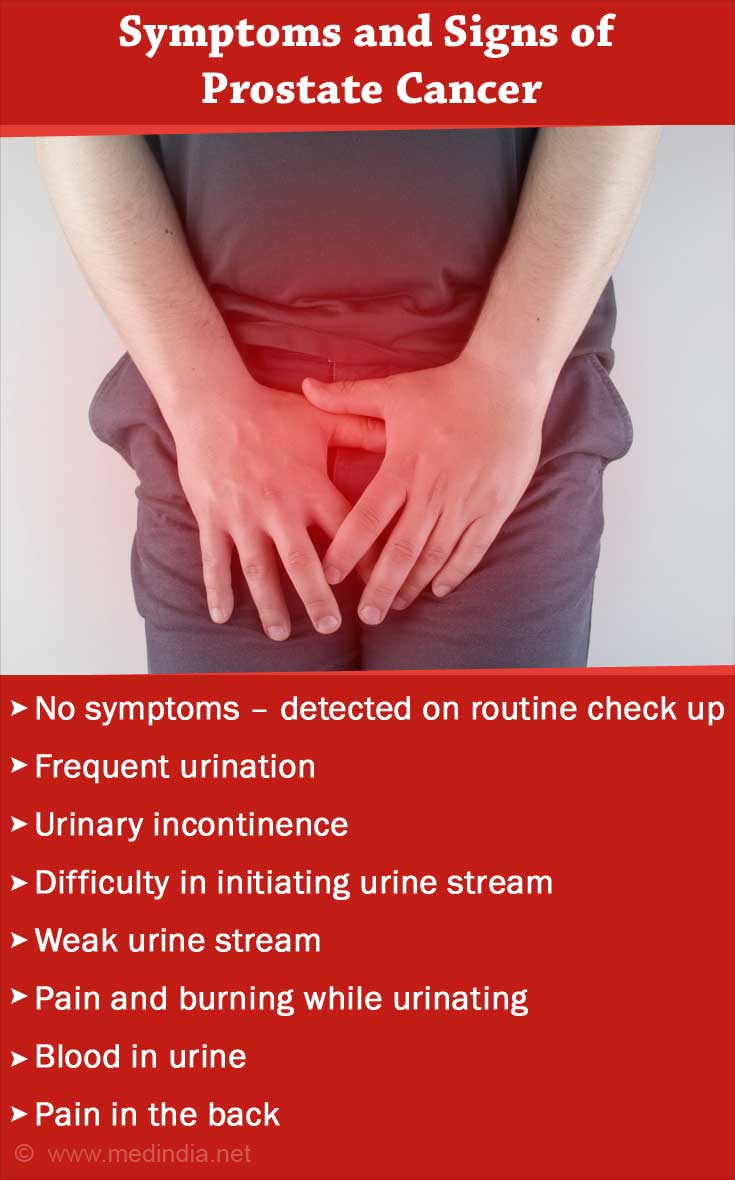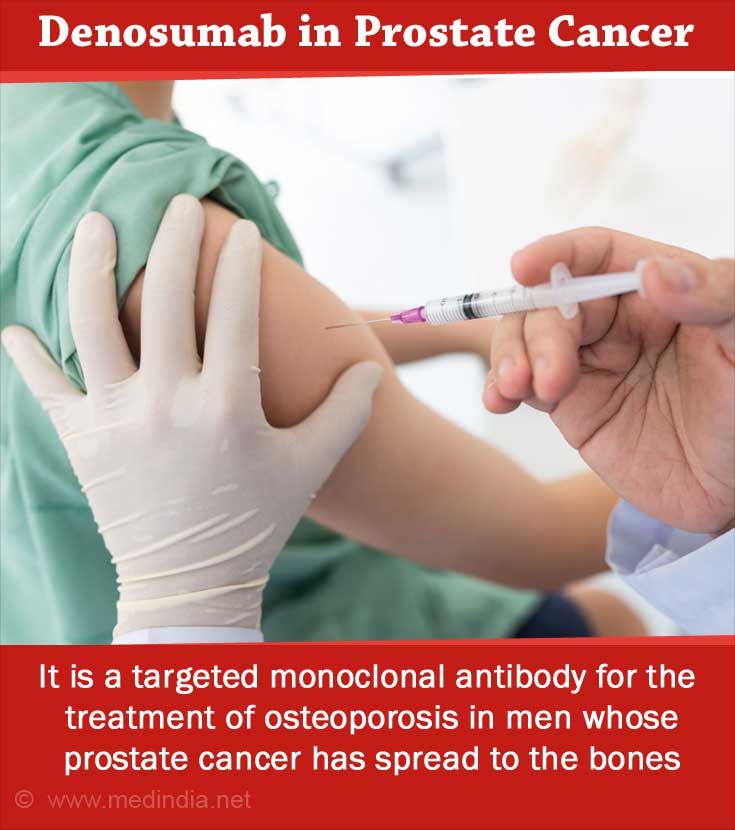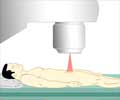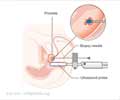- Cancer Facts and Statistics - (http://www.cancer.org/acs/groups/content/@epidemiologysurveilance/documents/document/acspc-026238.pdf)
- Carlos J, Mario R, Ellen S, McGee D, et al. (2013) Physical Activity and Prostate Cancer Mortality in Puerto Rican Men, Journal of Physical Activity & Men; 5(6): 918 – 929.
- Gathirua WG & Zhang J (2014) Dietary factors and risk for advanced prostate cancer. Eur J Cancer Prev; 23(2):96-109.
- Hayes JH, Ollendorf DA, Pearson SD, Barry MJ, et al. (2010) Active surveillance compared with initial treatment for men with low-risk prostate cancer: a decision analysis. JAMA; 304(21):2373-80.
- Longest Prostate Cancer Active Surveillance Study Promising - (http://www.medscape.com/viewarticle/823590)
- Ryan CJ, Smith MR, Fizazi K, Saad F, Mulders PF, et al. (2015) Abiraterone acetate plus prednisone versus placebo plus prednisone in chemotherapy-naive men with metastatic castration-resistant prostate cancer (COU-AA-302): final overall survival analysis of a randomised, double-blind, placebo-controlled phase 3 study. Lancet Oncol; 16(2):152-60.
- The National Association of Proton Therapy (2015) Prostate Cancer Treatment May Be Better Than "Watchful Waiting" Option. [Online] Available at: Prostate Cancer Treatment May Be Better Than "Watchful Waiting" Option
- Wolf AM, Wender RC, Etzioni RB, Thompson IM, et al. (2010) American Cancer Society guideline for the early detection of prostate cancer: update 2010. CA Cancer J Clin; 60(2):70-98.
What is Medical Management of Prostate Cancer?
Prostate cancer is the second most common cancer in men after skin cancer and it is the sixth leading cause of death in men worldwide. Around 99% of prostate cancer are detected in men above age 50, although the recent trends show rise in number of prostate cancer cases in men aging 30 to 40 years.
Risk factors for developing prostate cancer are advanced age, family history of the disease, diet high in processed meat and dairy products, race and previous history of sexually transmitted diseases. Most of the prostate cancer are slow-growing in nature. Early detection of the condition provide excellent prognosis for cure. However as it is a silent disease the detection is usually late and in many cases the disease has already advanced stage by the time the diagnosis is made.
Prostate cancer can be managed medically or surgically depending on different factors including stage of the disease at the time of diagnosis, age of the patients and associated co-morbid conditions. In a relatively young patients the intent to cure the cancer usually means surgical treatment and this gives the best results. However in an elderly patient above the age of 75 to 80 years or if the disease is in advanced stage when detected, medical treatment is advocated.
What is Prostate Gland & How Does it Function?
Prostate is a walnut sized gland of male reproductive system present below the urinary bladder and anterior to the rectum. Main function of prostate gland is fluid production required for semen.
How do you Stage Prostate Cancer?
Staging of prostate cancer is based on the extent of disease spread.
- Stage 1 signifies the localised cancer which is present on one-half or less of the prostate gland.
- Stage 2 is also localised cancer which is present on both the lobes of prostate gland.
- In stage 3, cancer cell spread to the outer layer of prostate to seminal vesicle.
- In stage 4 the cancer spreads to distal organs like rectum, bladder, pelvic wall, and bones.
How is Prostate Cancer Detected?
There are no specific symptoms that can be related to prostate cancer as these symptoms can also be observed in other conditions like enlargement of prostate gland due to benign prostatic hyperplasia.
Common sign and symptoms include:
- Frequent urination
- Urinary incontinence

- Difficulty in initiating urine stream
- Weak urine stream
- Pain and burning while urinating
- Blood in urine
- Pain in back and pelvic area
The three common diagnostic tests which confirm prostate cancer are rectal examination, prostate-specific antigen (PSA) test and biopsy of the gland. Urologists perform rectal examination manually and sometimes also use Ultrasound sonography (USG) or Magnetic resonance imaging (MRI) to supplement their findings. In a case of suspected cancer, biopsy sample are taken by urologist using a small biopsy needle which carries hollow-core needles.
PSA is a protein specifically produced by prostate gland and therefore detecting the PSA levels in blood serum is helpful in screening prostate cancer. Blood serum levels of PSA less than 4 ng/ml is considered normal. However, higher PSA level dose not confirm prostate cancer since higher levels of this protein can also be seen in conditions like benign prostate enlargement, recent biopsy of prostate gland, inflammation of the gland, or recent ejaculation.
How to Medically Manage Prostate Cancer?
Different treatment modalities are applied as per the condition of the patient as well as the extent of the disease.
Watchful Waiting
Patients with advanced age and comorbid conditions or those with life expectancy of less than 10 years are recommended for watchful waiting. Quality of life of such patients can get highly compromised if they are extensively treated for the cancer rather than waiting for disease progression. Such patients are monitored and as and when there is local or metastatic progression, palliative care is given to them as in order to relieve symptoms and improve overall life quality.

Over the years, watchful waiting approach has been advised for elderly men with localised prostate cancer. However, a recent observational study on 49,000 prostate cancer patients ageing 65 years or more found that patients who receive treatment in form of radical prostatectomy or radiation therapy tend to live more by at least 30% as compared to those who opt for watchful waiting.
Active Surveillance
Active surveillance is recommended for the patients with low-risk disease whose PSA levels are below 10ng/ml. This maybe a better strategy for treating these low risk prostate cancer rather than watchful waiting. Such patients are frequently screened for progression of cancer and are treated accordingly.
Researchers at the European Association of Urology performed a lengthy follow-up study to identify the effectiveness of active surveillance approach. The outcomes of the study suggested that this is a safe and feasible approach for the patients with low or intermediate risk. Death rate after 20 years of diagnosis with this approach was only 1.3% while the rate for development of metastatic cancer was as low as 3.1%.
Medical Treatment Drug Options include:
- Hormone therapy
- Chemotherapy
- Immune therapy using vaccines
- Biphosponates
- Denusomab
- Radioisotope treatment
Hormone therapy
Removing or blocking the action of hormones which allows the progression of prostate cancer cells is the main aim of hormone therapy. Different hormonal drugs reduces the production and level of male hormones like testosterone and androgens in the patient and therefore stuns the growth of cancer cells.
The hormonal drugs used to treat prostate cancer are as follows:
- LH releasing hormone agonist: Drugs like leuprolide, buserelin, and goserelin prevents the male testicles from producing testosterone.
- Antiandrogen drugs like flutamide, enzalutamide, and bicalutamide antagonise the action of androgens like testosterone and therefore hampers the promotion of male sex characteristics.

- Drugs like ketoconazole and aminoglutethimide are also used to antagonise adrenal glands and therefore reduce the production of male hormones.
- Abiraterone: A new drug approved by US FDA in the year 2011, Abiraterone inhibits the production of androgens by testicular, adrenal and prostatic tumour tissues. Since androgens are precursor for testosterone, inhibiting them reduces circulating levels of testosterone and thus reduces the progression of prostate cancer.
- Female sex hormone, oestrogen prevents the production of testosterone. However, these drugs are rarely used considering the serious side effects associated with them.
In few cases, surgical dissection of one or both testicles is done to inhibit the production of testosterones. The procedure is known as Orchiectomy.
Major side effects associated with hormone therapy and orchiectomy are nausea, diarrhoea, rashes, hot flashes, impotence, and reduced libido. Patients taking long-term hormone therapy can develop osteoarthritis. Long term hormone therapy may lead to development of resistance to the treatment. Such cancer is known as castrate-resistant prostate cancer.
Chemotherapy
Castrate-resistant prostate cancer is treated with chemotherapy or using some newer drugs like abiraterone. A recent randomised control trial highlighted that abiraterone in combination with prednisone is an effective and significantly safe regime for chemotherapy-naive men with metastatic castration-resistant prostate cancer. The adverse effects observed with the therapy are hypertension and increased alanine aminotransferase levels.
Chemotherapy is mainly applied to the patients with extensive metastasis of disease and for whom the hormonal therapy has failed. Chemotherapy is also used for castrate-resistant prostate cancer. Two or more chemotherapeutic agents are administered to the patient on multiple sittings. The drugs kill the cancer cells by hampering their division and multiplication. However, the drugs also affects the normal cells and the most common adverse effects thus observed are nausea, alopecia, anorexia, fatigue, and reduced blood cell counts. These adverse effects are resolved after completion of chemotherapy.
Drugs used for chemotherapy are docetaxel or cabazitaxel, given along with steroids or using combination of bevacizumab, thalidomide and steroids.
American Society of Clinical Oncology has established the combination of docetaxel and prednisone as standard chemotherapeutic care for advanced prostate cancer based on the outcomes of two large phase III clinical trials. The combination has been found to improve survival of the patient with advanced prostate cancer by two to three month median time. The combination provides similar results in hormone resistant prostate cancer.
Immune-system enhancing drugs
These drugs boost and restore natural immunity of the body to fight cancer. Example: Sipuleucel-T a vaccine is a cell based cancer immunotherapy. The vaccine is a personalised treatment and is developed individually for each patient. White blood cells extracted from the patient are treated in laboratory to develop the vaccine which is then infused to the patient in three sittings. The treatment has been observed to increase life expectancy of the patient by minimum 4.1 months, while 31.7% patients in a study were found to survive up to 36 months.
However, the adverse effects of the treatment are often debilitating. Major adverse effects are coughing, bloody urine, chills, chest pain, body ache, difficulty in speech or loss of speech, difficult movement of limbs and facial muscles, confusion, and breathing difficulty.
Bisphosphonate therapy for Bone Pain
Bisphosphonate group of drugs aids in reducing pain as well as lowering high serum calcium levels occurring due to metastasis of prostate cancer to bones. The drugs mainly acts on osteoclasts, which are cells responsible for breaking down the mineral structure of bone in order to keep them healthy. However, in case of bone metastasis, these cells become overactive and therefore leads to pain, thinning of bone, and development of osteoporosis. Zoledronic acid is most used bisphosphonate class of drug which is administered via intravenous route (IV route) every 3 or 4 weeks. The treatment is also used for preventing development and progression of osteoporosis in prostate cancer patients taking hormone therapy.
The common side effects are flu-like symptoms and joint pain. The treatment is contraindicated in patients with poor kidney function. The rare but extremely serious complication of the treatment is osteonecrosis of the jaw (ONJ). The treatment can hamper the blood supply to jaw bone and thus lead to tooth loss and open sores. Often infection is developed in the open sores which are hard to treat. Doctors usually advice patients to get treated for any dental and oral problem before initiation of therapy and also advice to maintain high standard oral hygiene during the course of therapy.
Denosumab
Denosumab is a targeted monoclonal antibody for the treatment of osteoprorosis in men with metastatic prostate cancer spread to bones and/or who are taking hormone treatment. The antibody also aids in relieving bone pain. Denosumab prevents maturation of osteoclasts which are bone-scavenging cells.
Denosumab therapy is contraindicated in patients with low serum calcium levels and can be resumed only after treatment of calcium and vitamin D deficiency. Common side effects are joint and bone pain. The treatment increases the risk for bone infections, hypersensitivity allergic reactions, skin allergy and infection, hip fractures, and osteonecrosis of jaw.

Radioisotope Strontium-89
Strontium-89 is a radiopharmaceutical agent which is similar to calcium and therefore is readily taken up by bone-forming cells called osteoblasts. The radioactive isotope is selective for bone and therefore provides better results and lower side effects than systemic radiotherapy for the treatment of bone metastasis of prostate cancer.
Strontium-89 is given intravenously to the patient which is then absorbed by bone cells. Unabsorbed agent is excreted in urine within 2-3 days of administration. The agent remains on the bone target for 100 days and kills metastatic cells by emitting beta radiations. Minimal irradiation to healthy tissues and longer duration of target specific activity are the main advantages of this treatment. Since the agent penetrates deep inside the bones, often there is no need to isolate the patient in a separate room.










